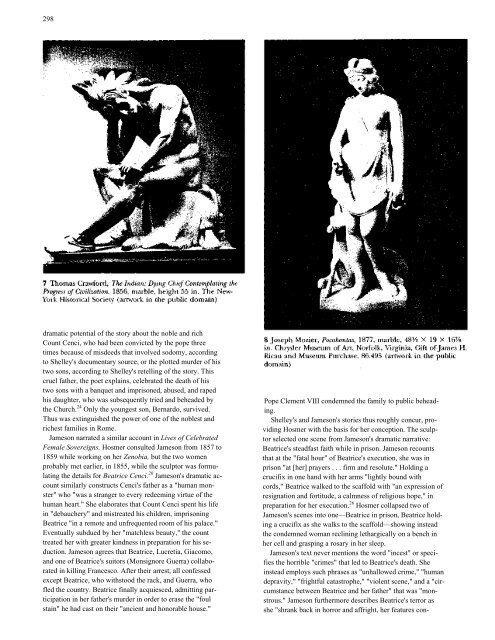of Incest and Female Relations in Harriet Hosmer's Beatrice Cenci
of Incest and Female Relations in Harriet Hosmer's Beatrice Cenci
of Incest and Female Relations in Harriet Hosmer's Beatrice Cenci
You also want an ePaper? Increase the reach of your titles
YUMPU automatically turns print PDFs into web optimized ePapers that Google loves.
298<br />
dramatic potential <strong>of</strong> the story about the noble <strong>and</strong> rich<br />
Count <strong>Cenci</strong>, who had been convicted by the pope three<br />
times because <strong>of</strong> misdeeds that <strong>in</strong>volved sodomy, accord<strong>in</strong>g<br />
to Shelley's documentary source, or the plotted murder <strong>of</strong> his<br />
two sons, accord<strong>in</strong>g to Shelley's retell<strong>in</strong>g <strong>of</strong> the story. This<br />
cruel father, the poet expla<strong>in</strong>s, celebrated the death <strong>of</strong> his<br />
two sons with a banquet <strong>and</strong> imprisoned, abused, <strong>and</strong> raped<br />
his daughter, who was subsequently tried <strong>and</strong> beheaded by<br />
the Church. 24 Only the youngest son, Bernardo, survived.<br />
Thus was ext<strong>in</strong>guished the power <strong>of</strong> one <strong>of</strong> the noblest <strong>and</strong><br />
richest families <strong>in</strong> Rome.<br />
Jameson narrated a similar account <strong>in</strong> Lives <strong>of</strong> Celebrated<br />
<strong>Female</strong> Sovereigns. Hosmer consulted Jameson from 1857 to<br />
1859 while work<strong>in</strong>g on her Zenobia, but the two women<br />
probably met earlier, <strong>in</strong> 1855, while the sculptor was formu-<br />
lat<strong>in</strong>g the details for <strong>Beatrice</strong> <strong>Cenci</strong>. 20 Jameson's dramatic ac-<br />
count similarly constructs <strong>Cenci</strong>'s father as a "human mon-<br />
ster" who "was a stranger to every redeem<strong>in</strong>g virtue <strong>of</strong> the<br />
human heart." She elaborates that Count <strong>Cenci</strong> spent his life<br />
<strong>in</strong> "debauchery" <strong>and</strong> mistreated his children, imprison<strong>in</strong>g<br />
<strong>Beatrice</strong> "<strong>in</strong> a remote <strong>and</strong> unfrequented room <strong>of</strong> his palace."<br />
Eventually subdued by her "matchless beauty," the count<br />
treated her with greater k<strong>in</strong>dness <strong>in</strong> preparation for his se-<br />
duction. Jameson agrees that <strong>Beatrice</strong>, Lucretia, Giacomo,<br />
<strong>and</strong> one <strong>of</strong> <strong>Beatrice</strong>'s suitors (Monsignore Guerra) collabo-<br />
rated <strong>in</strong> kill<strong>in</strong>g Francesco. After their arrest, all confessed<br />
except <strong>Beatrice</strong>, who withstood the rack, <strong>and</strong> Guerra, who<br />
fled the country. <strong>Beatrice</strong> f<strong>in</strong>ally acquiesced, admitt<strong>in</strong>g par-<br />
ticipation <strong>in</strong> her father's murder <strong>in</strong> order to erase the "foul<br />
sta<strong>in</strong>" he had cast on their "ancient <strong>and</strong> honorable house."<br />
Pope Clement VIII condemned the family to public behead-<br />
<strong>in</strong>g.<br />
Shelley's <strong>and</strong> Jameson's stories thus roughly concur, pro-<br />
vid<strong>in</strong>g Hosmer with the basis for her conception. The sculp-<br />
tor selected one scene from Jameson's dramatic narrative:<br />
<strong>Beatrice</strong>'s steadfast faith while <strong>in</strong> prison. Jameson recounts<br />
that at the "fatal hour" <strong>of</strong> <strong>Beatrice</strong>'s execution, she was <strong>in</strong><br />
prison "at [her] prayers . . . firm <strong>and</strong> resolute." Hold<strong>in</strong>g a<br />
crucifix <strong>in</strong> one h<strong>and</strong> with her arms "lightly bound with<br />
cords," <strong>Beatrice</strong> walked to the scaffold with "an expression <strong>of</strong><br />
resignation <strong>and</strong> fortitude, a calmness <strong>of</strong> religious hope," <strong>in</strong><br />
preparation for her execution. 26 Hosmer collapsed two <strong>of</strong><br />
Jameson's scenes <strong>in</strong>to one—<strong>Beatrice</strong> <strong>in</strong> prison, <strong>Beatrice</strong> hold-<br />
<strong>in</strong>g a crucifix as she walks to the scaffold—show<strong>in</strong>g <strong>in</strong>stead<br />
the condemned woman recl<strong>in</strong><strong>in</strong>g lethargically on a bench <strong>in</strong><br />
her cell <strong>and</strong> grasp<strong>in</strong>g a rosary <strong>in</strong> her sleep.<br />
Jameson's text never mentions the word "<strong>in</strong>cest" or speci-<br />
fies the horrible "crimes" that led to <strong>Beatrice</strong>'s death. She<br />
<strong>in</strong>stead employs such phrases as "unhallowed crime," "human<br />
depravity," "frightful catastrophe," "violent scene," <strong>and</strong> a "cir-<br />
cumstance between <strong>Beatrice</strong> <strong>and</strong> her father" that was "mon-<br />
strous." Jameson furthermore describes <strong>Beatrice</strong>'s terror as<br />
she "shrank back <strong>in</strong> horror <strong>and</strong> affright, her features con-
















